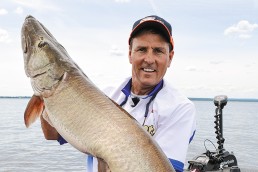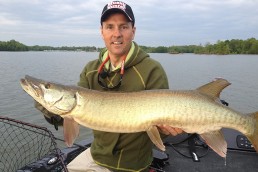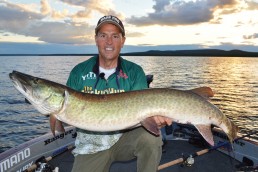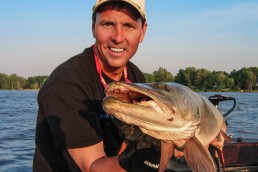Time Management Muskies
SHARE THIS POST
Whether you’re about to embark on your first early-season muskie trip or if your season is still months away and you’re examining all the new tackle you have accumulated over the sport show season, I want you to consider once concept—time management.
It is one of the most important, yet difficult aspects of muskie fishing to master. It is certainly not as glamorous as casting that new rod and reel or watching that new, color hi-tech sonar, but it can impact your results more than both combined. Time management takes both thinking and a little luck to gain the most benefit. After all, time management is how you are answering two of the most frequently asked questions in muskie fishing: How long do I fish a spot? How long do I stick with a lure?
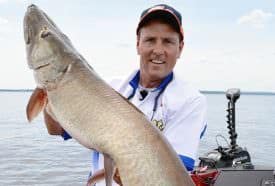
Those are two pretty tough questions, with no absolutes. How you answer or react to those questions can make or break a day. There are many factors that influence how long to fish a spot as well as what types. Likewise, when you consider how long to stick with a particular lure, the variables that are involved are endless. Many of the answers to these questions revolve around time management. Specifically, the time you have to maximize on the water. You don’t want to spend too much time in any one spot or with any one lure, unless, of course, you are having the success you anticipated. How you manage the clock for a given day, or what could be a brief morning or evening fishing stint, can have tremendous impact on your success.
Fishing tournaments really help develop time management skills. Frequently, how you perform in a tournament comes down to a few decisions you make, regarding spot or lure selection, and how much time to spend with each. Tournament fishing really helped me frame an approach for many situations, but I also learned that fishing under non-tournament conditions at times requires a different mindset. Furthermore, how you use your time may be as much dependent upon the amount of time you have to fish on any given day (i.e., the weather).
When you approach a given fishing day, one of the keys to consider is to know how much time you have. It really makes a difference if it is three hours versus 10 hours. There is only so much experimenting you can do in a short day, morning or evening stint—you have to make the most of it.
Long days of muskie fishing, particularly in summer, can be 10 to 12 hours, or even more, depending on your endurance. You have a lot more time to experiment and thoroughly work different areas and exhaust various patterns. I always try to make sure I go thorough a mental list of spot types and lures. If you feel you gave it your best and tried multiple types of structure, cover, and lures, you just have to get up the next day and try again.
It is obviously advantageous to be able to spend long days on the water. Even if you aren’t catching fish, you are learning, either where the fish are via follows, or as I like to say, “eliminating options,” if there appears to be no muskies in sight. Having time to thoroughly check out different types of cover with different lures can really help, particularly when conditions turn prime.
Despite having several hours to thoroughly fish many spots, you still have to manage the clock. I have had it happen many times when the day slipped away.
Are you enjoying this post?
You can be among the first to get the latest info on where to go, what to use and how to use it!
What do I mean by that?
Simply put, even on those marathon days you have to vary the pace with which you fish to be most successful—and keep track of time.
I’ll break a full day into periods: morning, afternoon and evening. In both the morning and evening periods, I’ll make sure I am keeping track of time and moving quickly. During these lower light periods, muskies should be more active. I’ll typically fish faster not only by moving my boat quicker with my trolling motor, but by using more aggressive, faster moving lures such as bucktails, quick-hopped glider jerkbaits or topwaters. I treat these periods in a similar fashion in that I am looking for active muskies. However, since I have a full day, I will also use faster-moving lures because I know I can go back and recheck similar spots with slower-moving presentations in the afternoon. Even if conditions appear tough, I’ll still try to make the most of the morning and evening periods by keeping my boat moving through the spots. It is just that I might decide to use slower, more finesse-type lures like minnowbaits and soft plastics.
With regard to spot selection, I’ll certainly first try my most productive spots, but I’ll also try new spots under prime conditions. You have to do some experimenting when conditions are good to see if a spot can produce. The point here is to take advantage of the long day to both check out new spots and maximize the periods when fish are most aggressive and cover water.
During the afternoon period, I’ll generally slow my boat speed and more thoroughly to cover the spots. Thick cover areas will get more casts. Often it takes the right cast(s) to an area to get the fish to strike. You really have to avoid the temptation to keep up the same pace during the afternoon session as the morning or evening session. Given the higher sun exposure and considering the fact that possibly your top spots did not score, you have to make sure the other areas and patterns you are checking get their time. When taking this approach, I am trying to determine if I am really just eliminating an option or if there is a pattern there to be discovered. This requires more time on a spot to thoroughly fish it so you can ultimately find a new pattern or eliminate certain types of spots or cover.
This same philosophy of being thorough in the afternoons applies to lure selection. I’ll make it a point to try several different lure types in the afternoon. Again, most likely you have already fished some of your top spots and may be either fishing new ones or refishing a few of the same. I will now try totally different lure types and this may include putting away some of my personal favorites. That doesn’t mean changing lures every fifth cast, but it could mean trying a new lure on each spot or trying two different lures on one spot. Overall, I think I tend to switch lures more when things are tough, except when the fish appear to be following but not striking. In that situation, I’ll frequently change lures or at the very least retrieve speeds.
Finally, no matter how long or short the day, be aware of how much time you have and make sure you reserve time to fish the key spots you want on any given day.
MWO
SHARE THIS POST
Did you enjoy this post?
You can be among the first to get the latest info on where to go, what to use and how to use it!
Jim Saric
Jim Saric is a Legendary Angler in the Freshwater Fishing Hall of Fame, the host and executive producer of The Musky Hunter television series, editor at large of Musky Hunter magazine, a seven-time muskie tournament winner, and a contributing writer for numerous other publications.
